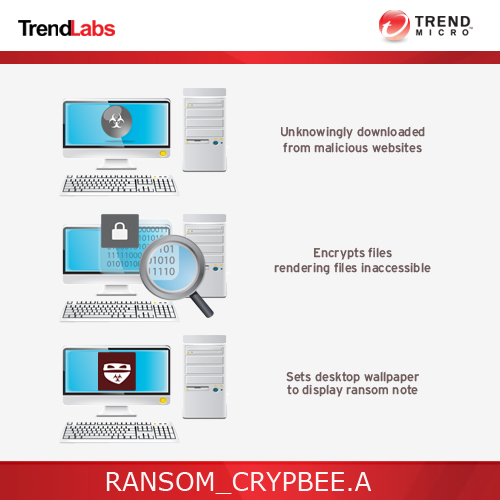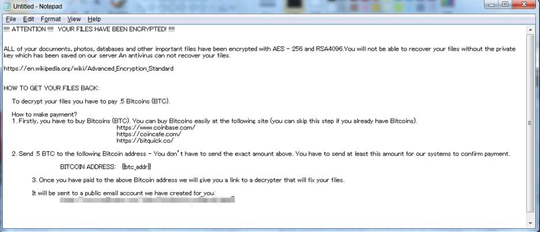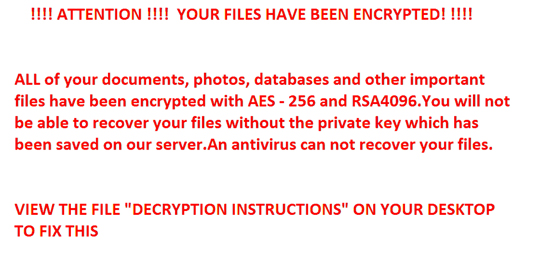RANSOM_CRYPBEE.A
a variant of Win32/Filecoder.NHJ (ESET); Trojan.Cryptolocker.N (Symantec);
Windows


Threat Type: Trojan
Destructiveness: No
Encrypted: Yes
In the wild: Yes
OVERVIEW
This ransomware, also known as R980 ransomware, resembles some aspects of RANSOM_MADLOCKER as it drops files other than ransom notes. It also avoids certain file paths. It asks its victims to pay .5 bitcoin as ransom.
To get a one-glance comprehensive view of the behavior of this Trojan, refer to the Threat Diagram shown below.

This Trojan arrives on a system as a file dropped by other malware or as a file downloaded unknowingly by users when visiting malicious sites.
It connects to certain websites to send and receive information.
TECHNICAL DETAILS
Arrival Details
This Trojan arrives on a system as a file dropped by other malware or as a file downloaded unknowingly by users when visiting malicious sites.
Installation
This Trojan drops the following copies of itself into the affected system and executes them:
- %User Temp%\taskhost.exe
(Note: %User Temp% is the user's temporary folder, where it usually is C:\Documents and Settings\{user name}\Local Settings\Temp on Windows 2000, Windows Server 2003, and Windows XP (32- and 64-bit); C:\Users\{user name}\AppData\Local\Temp on Windows Vista (32- and 64-bit), Windows 7 (32- and 64-bit), Windows 8 (32- and 64-bit), Windows 8.1 (32- and 64-bit), Windows Server 2008, and Windows Server 2012.)
It drops the following component file(s):
- %User Temp%\status.z
- %User Temp%\status2.z
- %User Temp%\k.z
- %User Temp%\rtext.txt (contains ransom note)
- %User Temp%\fnames.txt (contains filenames of encrypted files)
- %Desktop%\DECRYPTION INSTRUCTIONS.txt
(Note: %User Temp% is the user's temporary folder, where it usually is C:\Documents and Settings\{user name}\Local Settings\Temp on Windows 2000, Windows Server 2003, and Windows XP (32- and 64-bit); C:\Users\{user name}\AppData\Local\Temp on Windows Vista (32- and 64-bit), Windows 7 (32- and 64-bit), Windows 8 (32- and 64-bit), Windows 8.1 (32- and 64-bit), Windows Server 2008, and Windows Server 2012.. %Desktop% is the desktop folder, where it usually is C:\Documents and Settings\{user name}\Desktop in Windows 2000, Windows Server 2003, and Windows XP (32- and 64-bit); C:\Users\{user name}\Desktop in Windows Vista (32- and 64-bit), Windows 7 (32- and 64-bit), Windows 8 (32- and 64-bit), Windows 8.1 (32- and 64-bit), Windows Server 2008, and Windows Server 2012.)
Autostart Technique
This Trojan adds the following registry entries to enable its automatic execution at every system startup:
HKEY_CURRENT_USER\Software\Microsoft\
Windows\CurrentVersion\Run
BEECrypt = "%User Temp%\taskhost.exe"
Other System Modifications
This Trojan sets the system's desktop wallpaper to the following image:
Other Details
This Trojan connects to the following website to send and receive information:
- http://{BLOCKED}room.pk/assets/timepicker/x.php?
It encrypts files with the following extensions:
- .1cd
- .3dm
- .3ds
- .3fr
- .3g2
- .3ga
- .3gp
- .7z
- .DTD
- .PAS
- .RAW
- .a2c
- .aa3
- .aac
- .abu
- .acc
- .accdb
- .aepx
- .ai
- .aif
- .amr
- .ape
- .apnx
- .arc
- .ari
- .arp
- .arw
- .asf
- .asm
- .asp
- .aspx
- .ass
- .asx
- .av
- .ava
- .avi
- .azw
- .azw1
- .azw3
- .azw4
- .bad
- .bak
- .bas
- .bay
- .bdcr
- .bdcu
- .bdd
- .bdp
- .bds
- .bin
- .blend
- .bmp
- .bpdr
- .bpdu
- .bsdr
- .bsdu
- .c
- .cam
- .camproj
- .ccd
- .cdi
- .cdr
- .cer
- .cgi
- .cineon
- .class
- .cmf
- .cnf
- .conf
- .config
- .cpp
- .cr2
- .crt
- .crw
- .crwl
- .cry
- .cs
- .css
- .csv
- .ctl
- .cue
- .dash
- .dat
- .db
- .dbf
- .dbx
- .dcr
- .dd
- .dds
- .der
- .des
- .dgn
- .dicom
- .disc
- .dmg
- .dng
- .doc
- .docm
- .docx
- .dotm
- .dotx
- .dsc
- .dvd
- .dwg
- .dxf
- .dxg
- .eip
- .emf
- .eml
- .eps
- .erf
- .fdb
- .fff
- .fla
- .flv
- .fmb
- .fmt
- .fmx
- .gbr
- .gdb
- .gfx
- .gho
- .gif
- .groups
- .gsd
- .gsf
- .gzip
- .h
- .hdr
- .hpp
- .htm
- .html
- .iif
- .iiq
- .img
- .ims
- .indd
- .ini
- .iso
- .iss
- .jar
- .java
- .jfif
- .jge
- .jpe
- .jpeg
- .jpg
- .js
- .jsp
- .k25
- .kdc
- .key
- .kwm
- .lit
- .log
- .lst
- .lua
- .m
- .m3u
- .m4a
- .m4v
- .ma
- .max
- .md
- .mdb
- .mdf
- .mdk
- .mef
- .mkv
- .mobi
- .mov
- .movie
- .mp1
- .mp2
- .mp3
- .mp4
- .mp4v
- .mpa
- .mpe
- .mpeg
- .mpg
- .mpv2
- .mrw
- .msg
- .mts
- .nd
- .nef
- .nrg
- .nri
- .nrw
- .number
- .obj
- .odb
- .odm
- .odp
- .ods
- .odt
- .ogg
- .openexr
- .ora
- .orf
- .p12
- .p7b
- .p7c
- .pages
- .pas
- .pbm
- .pck
- .pdb
- .pdd
- .pef
- .pem
- .perl
- .pfx
- .pgm
- .php
- .pic
- .pkb
- .pks
- .pl
- .plb
- .pls
- .png
- .pot
- .potm
- .potx
- .ppam
- .ppm
- .pps
- .ppsm
- .ppsx
- .ppt
- .pptm
- .pptx
- .prf
- .prn
- .ps
- .psb
- .psd
- .pspimage
- .pst
- .ptx
- .pwm
- .py
- .qba
- .qbm
- .qbr
- .qbw
- .qbx
- .qby
- .qfx
- .r3d
- .raf
- .ram
- .rar
- .raw
- .rdf
- .rdo
- .rep
- .rex
- .rf
- .rgx
- .rik
- .rm
- .rpf
- .rtf
- .rw2
- .rwl
- .safe
- .sdf
- .sldm
- .sldx
- .sql
- .sqllite
- .sr2
- .srf
- .srt
- .srw
- .sti
- .stl
- .svg
- .swf
- .sxi
- .tax
- .tex
- .tga
- .thmx
- .tif
- .tiff
- .tlg
- .toast
- .txt
- .v2i
- .vbs
- .vcd
- .vdi
- .vlc
- .vob
- .vpd
- .vsd
- .wb2
- .wma
- .wmv
- .wpd
- .wps
- .x3f
- .xbm
- .xlam
- .xlk
- .xls
- .xlsb
- .xlsm
- .xlsx
- .xltm
- .xml
- .xps
- .xsl
- .yaml
- .yuv
- .zip
It renames encrypted files using the following names:
- {original file name and file extension}.crypt
NOTES:
This ransomware avoids encryption on the following file paths:
- Users\All Users
- $Recycle.Bin
- Program Files (x86)\\Google\\Chrome
- Program Files (x86)\\Mozilla Firefox
- Program Files\\Google\\Chrome
- Program Files\\Mozilla Firefox
It drops the following ransom note:

SOLUTION
Step 1
Before doing any scans, Windows XP, Windows Vista, and Windows 7 users must disable System Restore to allow full scanning of their computers.
Step 2
Note that not all files, folders, and registry keys and entries are installed on your computer during this malware's/spyware's/grayware's execution. This may be due to incomplete installation or other operating system conditions. If you do not find the same files/folders/registry information, please proceed to the next step.
Step 3
Scan your computer with your Trend Micro product to delete files detected as RANSOM_CRYPBEE.A. If the detected files have already been cleaned, deleted, or quarantined by your Trend Micro product, no further step is required. You may opt to simply delete the quarantined files. Please check this Knowledge Base page for more information.
Step 4
Restart in Safe Mode
Step 5
Delete this registry value
Important: Editing the Windows Registry incorrectly can lead to irreversible system malfunction. Please do this step only if you know how or you can ask assistance from your system administrator. Else, check this Microsoft article first before modifying your computer's registry.
- In HKEY_CURRENT_USER\Software\Microsoft\Windows\CurrentVersion\Run
- BEECrypt = "%User Temp%\taskhost.exe"
- BEECrypt = "%User Temp%\taskhost.exe"
Step 6
Search and delete these files
- %User Temp%\status.z
- %User Temp%\status2.z
- %User Temp%\k.z
- %User Temp%\rtext.txt
- %User Temp%\fnames.txt
- %Desktop%\DECRYPTION INSTRUCTIONS.txt
Step 7
Restart in normal mode and scan your computer with your Trend Micro product for files detected as RANSOM_CRYPBEE.A. If the detected files have already been cleaned, deleted, or quarantined by your Trend Micro product, no further step is required. You may opt to simply delete the quarantined files. Please check this Knowledge Base page for more information.
Step 8
Restore encrypted files from backup.
Did this description help? Tell us how we did.



